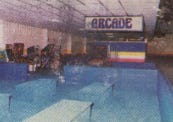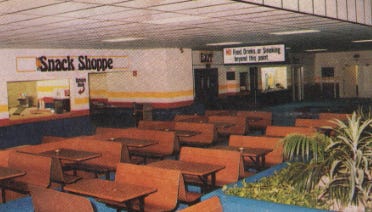The Proposition 2 ½ vote in East Bridgewater, Massachusetts, that affected the town during the years just prior to 1980 resulted in the local high school losing its hockey program due to budget constraints. The Crossroads Ice Rink that the town of East Bridgewater normally used for the school’s hockey games in the neighboring town of West Bridgewater suffered from a lack of funding as a result and, therefore, became available to bidders by the spring of 1980. “We were driving down the freeway and saw that rink just off the exit,” said eventual architect of Riverdale Rollerworld, Dick Young. “We pulled in, looked around, and asked the owner if he wanted to sell.” Dick Young along with his brother, Ted, were told, “Everything but my wife and my dog are for sale if you make the right offer!” According to Dick Young, “When we took over there were still ten days of ice hockey league play scheduled for that rink!” The Youngs would eventually melt and drain the ice surface while beginning to remodel the interior and by July 1980 they reopened the facility as Riverdale Rollerworld. At the time, roller skating was gaining popularity on the heels of the disco craze of the late 1970s with extended enthusiasm reaching out to the suburbs. Riverdale Rollerworld provided not only a place for local adults to take part in the activity of roller skating, but maybe more importantly created a common destination for kids from surrounding communities, a routine landing spot that would inadvertently help to foster adult independence. As the summer of 1980 was drawing to a close, Riverdale Rollerworld had arrived as the new place to be.
From the nearby town of East Bridgewater, the location of Riverdale Rollerworld was a little under ten miles away. As it required a ride to get there, a group of us would sometimes end up being driven in my family’s 1973 Plymouth Duster. If not, a friend’s parent up the street would take a group of us in their green Toyota Land Cruiser, a Jeep-like vehicle that is now quite rare and of significant current value but back then meant bouncing along untethered in the vehicle’s cargo section like you were a soldier being transported by Patton.
Upon being dropped off at Riverdale Rollerworld you walked through the doors, paid your admission, and proceeded to the window on your immediate left to trade your shoes in for a pair of roller skates. We knew a local East Bridgewater kid who worked there, which I always thought gave us the misdirected impression that we had some kind of priority status in terms of the quality of skates we were given. After lacing up our skates on a series of blue carpeted bench-like partitions, the easiest route to the main floor was directly through the arcade, a design that was surely intended to attract the attention of every kid passing through who came in with a pocket full of quarters. I was never much of a video game player, but I had a few friends who would spend a considerable amount of time playing either the classic pinball machines that were available, or the newer arcade games like Space Invaders, Asteroids, and eventually Pac-Man before ever thinking about getting on the floor to roller skate. This was all understandable. Being at Riverdale Rollerworld was as much about being on the scene as it was about actually roller skating.
At the far end of the arcade there was a small skating area designated for beginners where you could either check the fit of your skates or practice a bit before daring to head out to the main floor to begin skating. As co-owner Ted Young once said, “New skaters aren’t always ready to roll right into main floor traffic.” Roller skating requires the ability to continuously move in a giant circle keeping tempo with a large number of people of different levels attempting to basically remain in unison like a school of fish. Of course, you must do this while looking out for those skaters that might be on the aggressive side. In adult terms, the activity is a bit like driving on the highway. So long as you can keep up with everyone around you, roller skating is relatively easy, but you stick out like a sore thumb if you are too slow or you fall, at which point you become an embarrassing impediment to everyone else trying to get around you.
Riverdale Rollerworld’s interior was sectioned off with cinder block walls painted bright white with festive stripes of yellow, red, and blue. Positioned between the arcade area and the main floor for skating, a small square tower of similarly decorated cinder blocks housed the disc jockey who had a library of actual records playing hits of the time from above the floor like Bad Case of Loving You by Robert Palmer, I Love a Rainy Night by Eddie Rabbitt, Jessie’s Girl by Rick Springfield, or the newly released disco-influenced song by Queen, Another One Bites the Dust. These were the types of songs commonly played during what would be loudly announced by the DJ as All Skate sessions. The music, however, became far more mellow and romantic when Ladies Choice skate times were announced. Ladies Choice was called by the disc jockey multiple times each night featuring songs like We’ve Got Tonight by Bob Seger, You Decorated my Life by Kenny Rogers, Woman from John Lennon’s recent Double Fantasy album, and the song Babe from Styx. During Ladies Choice, couples were able to slowly skate around holding hands, the equivalent of a slow dance in motion, but only pairs were allowed to be on the floor.
Groups of people who were not skating would often be hanging out at the Snack Shoppe close to the building’s entryway. This Riverdale Rollerworld snack bar had a full-service counter area serving pizza, hot pretzels, popcorn, chips, fries, and sodas. But the hippest thing on the Snack Shoppe menu was the fake pina colada that you could order and sip on while sitting in one of the booths while talking with a group of your friends. Smoking was allowed in the snack bar area. It was 1980, after all, although there was a nearby sign informing you that “No food, drinks, or smoking” were allowed beyond the snack bar area. Due to Riverdale’s efforts to maintain the premises and guarantee a safe environment, gum chewing was not permitted while skating, and you were penalized with time off the main floor if you were caught by a Riverdale employee chewing gum. Similarly, Riverdale Rollerworld did not allow anyone into the building if they were wearing jeans. Therefore, roller skating nights required corduroys, the only other kind of pants we wore back then.
As the nights got later into Riverdale’s second session, an older crowd would often show up and take over the place. When the disc jockey announced that it was time for the Freestyle Skate, usually between the hours of 10:30 p.m. and midnight, a quick decision had to be made to either get off the floor or do your best to keep up with a rowdy crowd of skaters moving as quickly and aggressively as possible often cutting in and out of lanes in order to get around you. Falling or moving too slowly during the Freestyle Session could actually be dangerous. Freestyle was more like a competitive event that was sometimes better witnessed from the snack bar area where you could conveniently use the excuse that you were not skating, if timed correctly, because you were still working on your pina colada.
As the late nights at Riverdale Rollerworld came to a close your roller skates would need to be exchanged for the shoes that you showed up in at the busy window close to the exit. If prior arrangements had not been made for pick up you could find yourself trying to use the payphone to call for a ride which usually required waiting your turn before a phone was available. Crowds who had come from inside waited out by the awning gazing out at the access road anticipating their ride. You weren’t always sure what car to look for as your transportation might end up being someone else’s parent who had volunteered to drive over and do the pick up. On occasion, a pleasant surprise would be either of my sisters riding shotgun in a boyfriend’s truck, meaning we could all just hop in the back and enjoy the night air while riding home.
Riverdale Rollerworld served an important role in our local community all those years ago providing a definitive destination for kids on weekend nights, a place to gather where we were without supervision requiring independent responsibility. The thought of parents today allowing kids to be dropped off in a different town and then leaving them there until being later notified is almost unimaginable, while the opportunity to cultivate independence, solve potential problems without the security of a cellphone, and develop social relationships organically proved to be immeasurable.
Although I certainly didn’t recognize it at the time, my memories of Riverdale Rollerworld reinforce the idea that less parental involvement and more opportunities for self-exploration are important building blocks on the path to adulthood, all factors that appeared to be more evident decades ago - even if you didn’t order a pina colada.
If you like my articles, please hit the “LIKE” button. It will help to let me know that you are enjoying my writing.
I welcome and invite you to COMMENT.
And please SHARE these posts! This gives added support to my Substack page and also helps to add new readers.
Thanks so much to anyone who is reading Journeys with Jay!











Great article, Jay, although I would like to correct a few things. When I found the building, my brother was not with me. When the owner told me that everything was for sale except his wife and his dog, he continued: "but, I'll take offers on my wife...." The design of the facility was entirely my own; so, he was NOT the "architect" My brother's only involvement in the W.Bridgewater rink was as a part-owner of the building. If you, or anyone else, have any other questions, drop me a line at tedy52302@gmail.com.